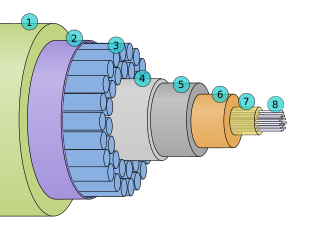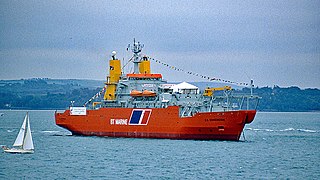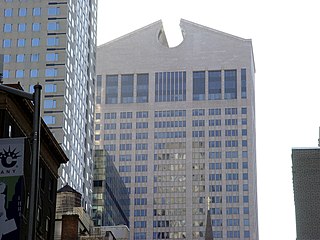TAT-6 was the sixth transatlantic telephone cable. It was in operation from 1976 to 1994, with a bandwidth of 12MHz between Green Hill and Saint-Hilaire-de-Riez, Vendée, (France).
CANTAT-1 was the first Canadian transatlantic telephone cable, between Hampden, Newfoundland and eventually Grosses-Roches, Quebec and Oban, United Kingdom, which followed on from the success of TAT-1. It was conceived and approved as stage one of a proposed commonwealth round the world cable and was done at a cost of $8,500,000. The system was jointly owned by Cable & Wireless and the Canadian Overseas Telecommunication Corporation (COTC).
A transatlantic telecommunications cable is a submarine communications cable connecting one side of the Atlantic Ocean to the other. In the 19th and early 20th centuries, each cable was a single wire. After mid-century, coaxial cable came into use, with amplifiers. Late in the 20th century, all cables installed use optical fiber as well as optical amplifiers, because distances range thousands of kilometers.

A submarine communications cable is a cable laid on the seabed between land-based stations to carry telecommunication signals across stretches of ocean and sea. The first submarine communications cables were laid beginning in the 1850s and carried telegraphy traffic, establishing the first instant telecommunications links between continents, such as the first transatlantic telegraph cable which became operational on 16 August 1858.

Commercial Pacific Cable Company was founded in 1901, and ceased operations in October 1951. It provided the first direct telegraph route from America to the Philippines, China, and Japan.

SAT-3/WASC or South Atlantic 3/West Africa Submarine Cable is a submarine communications cable linking Portugal and Spain to South Africa, with connections to several West African countries along the route.

A cable layer or cable ship is a deep-sea vessel designed and used to lay underwater cables for telecommunications, for electric power transmission, military, or other purposes. Cable ships are distinguished by large cable sheaves for guiding cable over bow or stern or both. Bow sheaves, some very large, were characteristic of all cable ships in the past, but newer ships are tending toward having stern sheaves only, as seen in the photo of CS Cable Innovator at the Port of Astoria on this page. The names of cable ships are often preceded by "C.S." as in CS Long Lines.

Global Marine Group is a British-headquartered specialist provider of installation, maintenance and repairs of submarine communications cable for the telecommunications, oil & gas and deep sea research industries. To this end, they operate their own a fleet of vessels, ROVs and specialised subsea trenching and burial equipment. Formerly known as Cable & Wireless Marine and British Telecom Marine, it was purchased by Global Crossing in 1999, at which time it received the name it carries today. In 2004, Global Marine Systems was purchased by Bridgehouse Marine and was completely restructured. In September 2014, Global Marine was acquired by HC2, and in 2020 by J F Lehman and partners. Historically, the company has a legacy of over 160 years of cable installation, stemming from the first telegraph cables laid in the 1850s.
The second CS Faraday was a cable ship built by Palmers Shipbuilding and Iron Company, Hebburn-on-Tyne, in 1922–23, as a replacement for the ageing CS Faraday built in 1874. Design of the new ship was influenced by long experience with the original ship.
USS Nashawena (AG-142/YAG-35) was a U.S. Navy cable layer constructed during World War II for the Army as the wooden-hulled self-propelled barge BSP 2008. The barge was completed converted to cable work for U.S. Army Signal Corps as the cable ship Col. William. A. Glassford supporting the Alaska Communications System in the shallow island waters of Alaska. She was transferred to the U.S. Navy in 1947 as a miscellaneous auxiliary and assigned to cable-laying duties for the U.S. Pacific Fleet.

The West Africa Cable System (WACS) is a submarine communications cable linking South Africa with the United Kingdom along the west coast of Africa that was constructed by Alcatel-Lucent. The cable consists of four fibre pairs and is 14,530 km in length, linking from Yzerfontein in the Western Cape of South Africa to London in the United Kingdom. It has 14 landing points, 12 along the western coast of Africa and 2 in Europe completed on land by a cable termination station in London. The total cost for the cable system is $650 million. WACS was originally known as the Africa West Coast Cable (AWCC) and was planned to branch to South America but this was dropped and the system eventually became the West African Cable System.

Africa Coast to Europe (ACE) is an optical-fiber submarine cable system serving 24 countries on the Europe, west coast and south Africa, managed by a consortium of 20 members.

AT&T Corporation, commonly referred to as AT&T, an abbreviation for its former name, the American Telephone and Telegraph Company, was an American telecommunications company that provided voice, video, data, and Internet telecommunications and professional services to businesses, consumers, and government agencies.

C.S. Sovereign is a class DP2 type cable ship used for subsea cable installation and repair works. The ship was designed by BT Marine with Hart Fenton & Company as Naval Architects and built by Van der Giessen de Noord in 1991.

The Mafuta is a diamond-mining ship owned and operated by De Beers in the western coast of South Africa. Built in 1983 as Dock Express 20 for Dock Express Shipping, the semisubmersible, multirole, heavy-lift vessel was converted to the world's largest cable layer in 1993. In 2005, she was purchased by De Beers, and converted to a subsea diamond-mining ship by A&P Tyne over the course of 11 months. The ship's new name, Peace in Africa, may have implied that it was providing an alternative to blood diamonds. In 2013, still under ownership of De Beers Marine Namibia, the vessel was renamed to MV Mafuta.
The Eastern Mediterranean Optical System (EMOS-1) is a fiber optic cable linking Palermo, Italy with Lechaina, Greece; Marmaris, Turkey and Tel Aviv, Israel, which was created in Turkey in 1991. Consisting of three pairs which are split en route through branching units. The ship CS Vercors laid the cable. Each pair of fibres are capable of transmitting 1920 telephone calls in each direction.

Orange Marine is a wholly owned subsidiary of Orange S.A. It is a major actor in the laying of new submarine communications cables and the maintenance of existing cables across the world's oceans. The company is active in all areas of these activities, including the study (survey) and the shore ends. Orange Marine took control of Elettra on 1 October 2010, and now operates six cable ships, which is 15% of the world fleet. The CEO of Orange Marine and Elettra is Didier Dillard.
HMTS Monarch, launched on 8 August 1945 and completed during February 1946, was the fourth cable ship with that name. The ship was built for the General Post Office (GPO) for the laying and repair of submarine communications cable and was the largest cable ship in the world when completed and the first cable ship to have all electric cable machinery.

CCGS John Cabot was a Canadian Coast Guard heavy icebreaker and cable ship in service starting 1965. It passed out of CCG service and entered private service in 1994, as the cable ship CS John Cabot. In 1997, it was again renamed, becoming CS Certamen. The ship was scrapped in 2014, under the name Certa. It was the world's first icebreaking cable repair ship built. In 1985, it recovered the black boxes from Air India Flight 182. As of 2023, the John Cabot participated in the deepest submarine rescue ever performed, in 1973, retrieving Pisces III from the seafloor at 480 m (1,570 ft) and rescuing the crew of Roger Mallinson and Roger Chapman.











